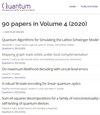Simulation of open quantum systems on universal quantum computers
IF 5.1
2区 物理与天体物理
Q1 PHYSICS, MULTIDISCIPLINARY
引用次数: 0
Abstract
The rapid development of quantum computers has enabled demonstrations of quantum advantages on various tasks. However, real quantum systems are always dissipative due to their inevitable interaction with the environment, and the resulting non-unitary dynamics make quantum simulation challenging with only unitary quantum gates. In this work, we present an innovative and scalable method to simulate open quantum systems using quantum computers. We define an adjoint density matrix as a counterpart of the true density matrix, which reduces to a mixed-unitary quantum channel and thus can be effectively sampled using quantum computers. This method has several benefits, including no need for auxiliary qubits and noteworthy scalability. Moreover, some long-time properties like steady states and the thermal equilibrium can also be investigated as the adjoint density matrix and the true dissipated one converge to the same state. Finally, we present deployments of this theory in the dissipative quantum $XY$ model for the evolution of correlation and entropy with short-time dynamics and the disordered Heisenberg model for many-body localization with long-time dynamics. This work promotes the study of real-world many-body dynamics with quantum computers, highlighting the potential to demonstrate practical quantum advantages.开放量子系统在通用量子计算机上的模拟
量子计算机的快速发展使量子优势在各种任务上得到了展示。然而,真实的量子系统总是耗散的,因为它们不可避免地与环境相互作用,由此产生的非幺正动力学使得只有幺正量子门的量子模拟具有挑战性。在这项工作中,我们提出了一种创新的、可扩展的方法来模拟使用量子计算机的开放量子系统。我们将伴随密度矩阵定义为真密度矩阵的对应物,将其简化为混合酉量子信道,从而可以使用量子计算机有效地进行采样。这种方法有几个优点,包括不需要辅助量子位和显著的可扩展性。此外,当伴随密度矩阵和真耗散密度矩阵收敛于同一状态时,还可以研究稳态和热平衡等长时间性质。最后,我们介绍了该理论在相关和熵演化的耗散量子XY模型和多体局域化的长时间动力学的无序海森堡模型中的应用。这项工作促进了量子计算机对现实世界多体动力学的研究,突出了展示实际量子优势的潜力。
本文章由计算机程序翻译,如有差异,请以英文原文为准。
求助全文
约1分钟内获得全文
求助全文
来源期刊

Quantum
Physics and Astronomy-Physics and Astronomy (miscellaneous)
CiteScore
9.20
自引率
10.90%
发文量
241
审稿时长
16 weeks
期刊介绍:
Quantum is an open-access peer-reviewed journal for quantum science and related fields. Quantum is non-profit and community-run: an effort by researchers and for researchers to make science more open and publishing more transparent and efficient.
 求助内容:
求助内容: 应助结果提醒方式:
应助结果提醒方式:


